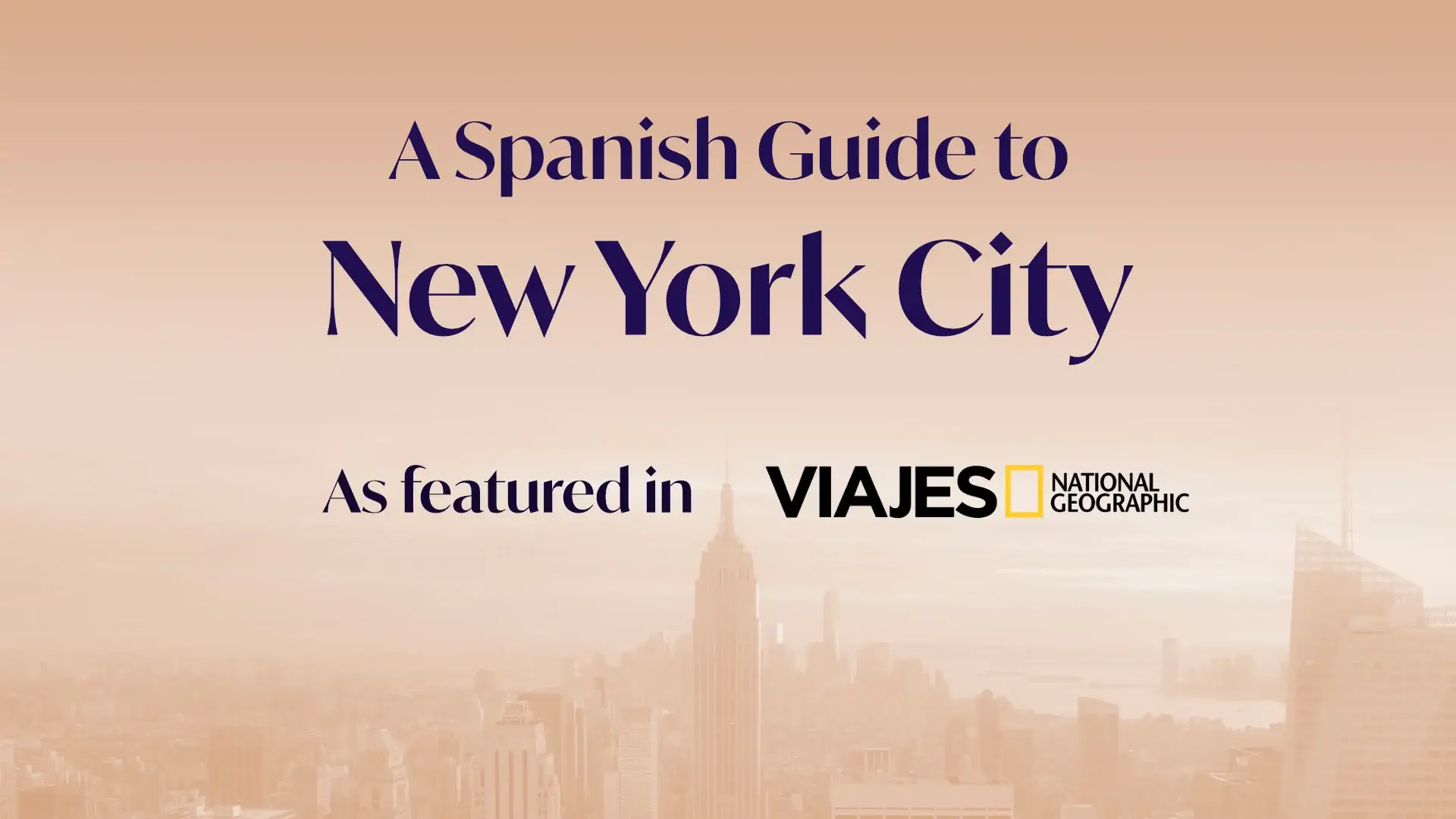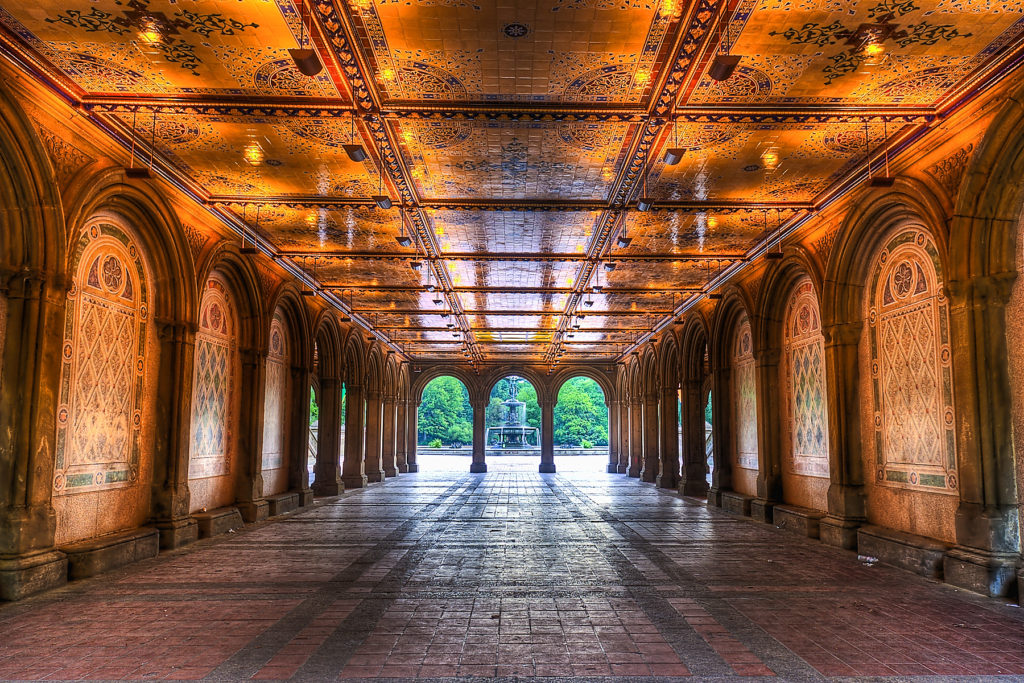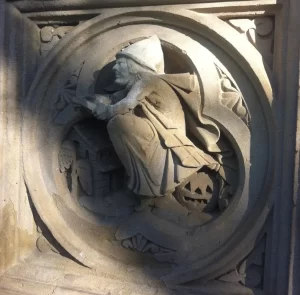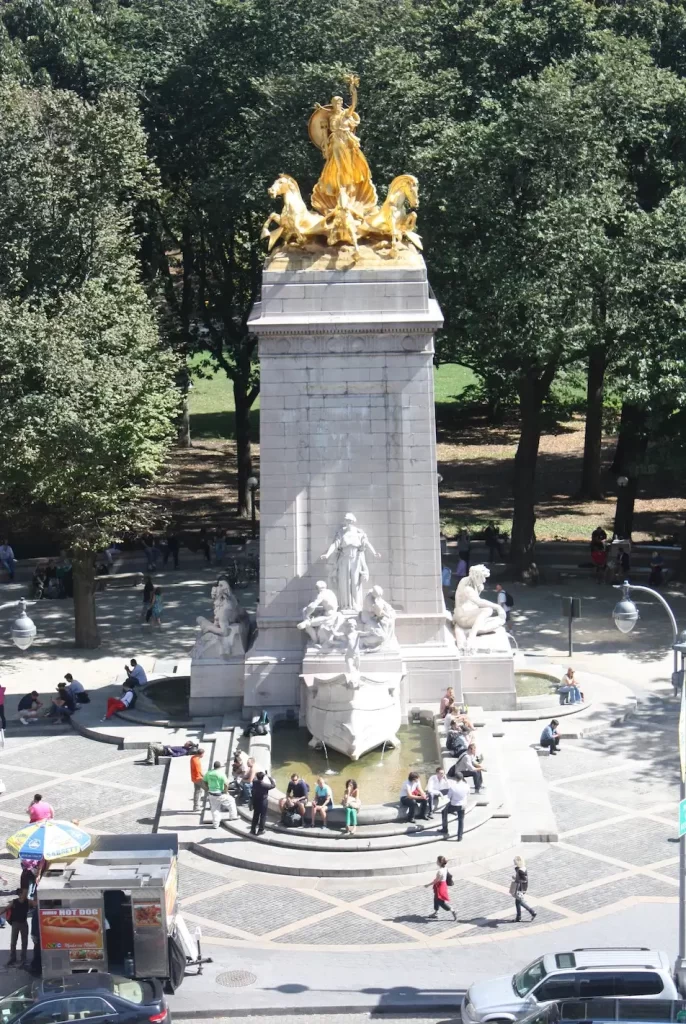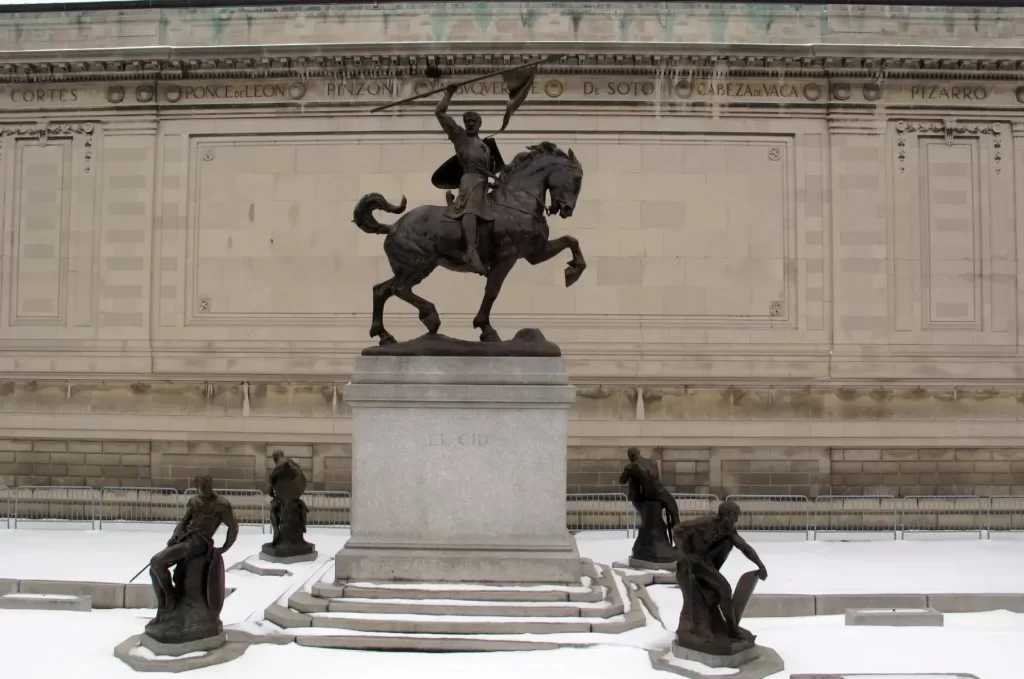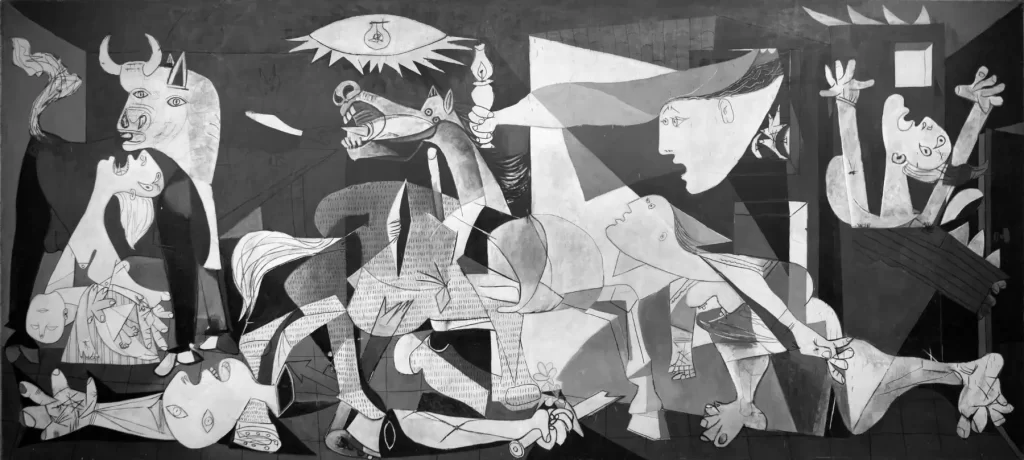As featured in Spanish in
The shared history of Spain and New York is a much-forgotten story. It’s a 400-year odyssey with pirates and shipwrecks, exiles and poets. A story of love and hate with a happy ending. This fairytale might seem unbelievable, but the evidence is hidden in plain sight. In this virtual tour, we’ll stop at ten Manhattan locations where Spain made its mark on New York. Through stories of all kinds, we’ll see how Spain and New York have shaped each other’s identities and how New Yorkers’ perception of Spain has changed over the centuries.
By Andrew Silverstein and Mercedes Vega Villar
Stop 1
Peter Stuyvesant’s Peg Leg in Stuyvesant Park
We start in Stuyvesant Park, a quiet greenspace in Manhattan surrounded by ivy-covered row houses. Spain had an impact on New York from its very start as a Dutch colony, New Amsterdam. We’re here to see a statue of Peter Stuyvesant (1592-1672), the Director General of the Dutch colony. Specifically, we’re looking at what remains of his right leg. In 1644, a Spanish cannon took Stuyvesant’s leg as he led a siege on the Caribbean island of San Martín. The loss of his leg may have contributed to his angry demeanor—he was known to have ruled New Amsterdam with a wooden leg and an iron fist. The Dutch colonists despised him so much that they were relieved when the British took over the colony in 1664 and renamed it New York.
In Stuyvesant’s New Amsterdam, Spaniards and Catholics were banned. It wasn’t personal—it was Dutch policy. The Eighty Years War against Spanish subjugation was still raging in Holland when the colony was founded in 1624. Nothing changed with the arrival of English, either, who had their own rivalry with Spain and distaste for Catholics. In British New York, priests were banned on penalty of death.
The sculptor of the statue, Gertrude Vanderbilt Whitney, was born into one of the world’s wealthiest families. She founded the Whitney Museum of American Art in 1931. In the US, Vanderbilt Whitney became known for her museum rather than her art. It is in Huelva, Spain, where she received recognition as an artist. There you can dine at Restaurante Bar Whitney located on Avenida Escultora Miss Whitney. The names give tribute to the artist for her 114 foot (35m) statue of Columbus in the city’s harbor. The 1929 sculpture, Monument to the Discovery Faith (in Spanish: Monumento a la Fe Descubridora), is one of the most recognized landmarks of the Andalusian city.
When Vanderbilt Whitney made this Stuyvesant statue in 1936, she was undoubtedly paying homage to the city’s Dutch roots. She herself was a descendent of Dutch colonists. But in 2013, the narrative of the city’s white protestant Dutch beginnings was challenged. Researchers discovered definitive evidence that New York’s first non-native resident was Juan Rodríguez. Rodriguez, born in the Dominican Republic to an African mother and a Portuguese father, worked on a Dutch ship. In 1613, he jumped ship and remained on Manhattan Island, marrying a woman of the Lenape tribe.
Detour: Pay your respects to New York’s other founding father, a Black-Latino-European polyglot. In Washington Heights, New York’s largest Dominican community, Broadway was designated Juan Rodríguez Way. The street celebrates him as the first settler and the first person to embody the multicultural nature of New York.
Stop 2
Spanish and Portuguese Jews: First Shearith Israel Graveyard
You could easily miss this tiny seventeenth-century cemetery tucked between the crowded apartment buildings and shops of Chinatown. It belongs to the Shearith Israel Synagogue of Spanish and Portuguese Jews, the oldest congregation in North America, established in 1654. In that year, a ship of 23 Sephardic Jews fled Brazil, escaped capture by Spanish pirates, and arrived in New Amsterdam. Stuyvesant tried to turn them away, writing to Holland of these “hateful enemies and blasphemers of the name of Christ.” His superiors insisted that Stuyvesant accept them.
The congregation Shearith Israel still survives today. In 1929, Frederico García Lorca visited the synagogue, writing to his family, “in Granada, almost all of us are Jews. It was a wonderful thing to see how they all looked like Granadinos.” A visit to this cemetery inspired Lorca’s poem, “Jewish Cemetery.” The graveyard and surrounding brick buildings with fire escapes remain unchanged from the time of Lorca’s visit. Lorca would have heard the screech of elevated train tracks (since removed) and the chatter of Jewish and Italian immigrants whose clotheslines crisscrossed over the tombstones. Before that, these buildings housed German and Irish families. Today, their inhabitants are mostly Chinese immigrants
Photo credit Wally Gobetz on Flickr
It is fitting that New York’s immigrant East Side took form around the Sephardic cemetery. The first Sephardic Jews added to an already diverse New Amsterdam where they spoke 18 different languages in its few streets. Their acceptance crystallized New York as a diverse and tolerant city, as opposed to the neighboring puritanical British colonies.
While Shearith Israel had a synagogue where Spanish classes were taught by 1730, the first Catholic church in New York would have to wait until after the colonial period. Funded by Spain’s King Carlos III, St. Peter’s (1785) was relegated to the outskirts of the city on Barclay Street.
Detour: Visit the nearby Church of the Transfiguration founded by another Spanish Empire refugee, Father Felix Varela. Father Varela escaped Spain in 1823 after advocating for the end of slavery and greater political independence in his native Cuba. Sentenced to death in absentia, Father Varela became a prominent leader of New York’s Irish Community in the Five Points neighborhood. Today, the church is the nation’s largest Chinese Catholic Church.
Stop 3
Bethesda Terrace: Alhambra in Central Park
This is the very heart of Central Park and one of New York’s most iconic sites. On a normal day, buskers play music and couples pose for wedding photos. New Yorkers and tourists alike escape the busy city and stop to appreciate the beauty of the terrace blending into nature, or relive one of the many movie scenes shot here. Few recognize that the Bethesda Terrace was inspired by the Alhambra of Granada.
The Bethesda Terrace was designed by Calvert Vaux and Jacob Wrey Mould. Mould spent two years in Granada studying the Alhambra. You can see the Moorish influences on the terrace’s intricate engravings and on the famed Milton tiles on the arcade’s ceiling above. It is not surprising that the centerpiece of Central Park has an Andalusian influence. New York’s first hispanist and important writer, Washington Irving, led the park’s advisory committee and later nicknamed the city Gotham. In 1832, he published Alhambra after living in the palace for two years.
Photo by Francisco Diez on Wikipedia
Following Irving’s lead, America’s conception of Spain began to change. The dark lens of the Black Legend was replaced by a new exotic, picturesque, and vibrant perspective. Irving’s writing influenced authors and artists to travel to Spain, leading the wealthiest New Yorkers to buy paintings by Goya, Velázquez, and El Greco. His work also inspired architects to reference the Alhambra and La Giralda in New York architecture (Second Madison Square Garden, Coney Island tower, and Municipal Building).
Despite a fascination with Spain (and Andalusia in particular), New Yorkers of the nineteenth century, including Irving, still saw Spain as backward and “Arabian.” The anti-Catholic sentiment of the time is carved in the stone of Bethesda Terrace. An engraved flying witch and jack-o-lantern represent Halloween, an Irish holiday with pagan roots. At the time, Halloween was used to question the Christianity of Irish immigrants. A full acceptance of Spain, Catholics, and Halloween would have to wait.
Detour: Take a walk to the Alice in Wonderland statue in Central Park by Spanish artist José de Creeft.
Stop 4
Columbus Circle
If you stand in Columbus Circle, you can see the alpha and omega of Imperial Spain. It starts with Columbus, whose 14-foot (4.3 meter) tall statue looks down on us from a 76-foot (23 meter) long column. It ends with the monument to the U.S.S. Maine at the entrance to Central Park.
The U.S.S. Maine was an American naval ship that mysteriously exploded in the Havana harbor in 1898. The loss of the U.S.S. Maine and death of 255 American sailors led the US to declare war. The Spanish-American War cost Spain its last colonies: Cuba, Puerto Rico, and the Philippines. The sculpture of “Columbia Triumphant” on top of the memorial was made from the ship’s bronze armaments that were salvaged from the bottom of the Havana harbor.
USS Maine National Monument Photo by Peterjr1961 on Wikipedia
It’s unclear if the U.S.S. Maine was actually lost to a Spanish attack or to an American accident. Nonetheless, the media mogul William Randolph Hearst spread anti-Spanish propaganda, propelling the country into war. From Columbus Circle, you can see the Hearst offices with their tower designed by Norman Foster in 2006.
The loss of the war shocked Spanish society. Referred to as “el desastre” or the disaster, it influenced the generation of 1898, a groundbreaking intellectual movement in Spain. In New York, debates erupted surrounding America’s new “possessions,” with many resisting the idea of an imperial US given its anti-colonial history.
Detour: Two blocks east are the statues of Latin American liberators, José Martí, Simón Bolívar, and José de San Martín, at the entrance to Central Park and 6th Avenue. Bolívar, the South American liberator, visited New York in 1807 and found inspiration for his revolution. Martí lived in New York for 15 years, joining a community of Spanish empire political refugees and found American support for his cause. It was in New York that the first Cuban flag was sewn. New York backed Latin American independence movements out of both anti-colonial convictions and economic interests. In 1945, 6th Avenue was named, “Avenue of the Americas.”
Stop 5
The Hispanic Society of America Museum & Library
By 1900, New York was one of the world’s largest and wealthiest cities. Looking to compete with European dukes and barons, wealthy New Yorkers filled their Fifth Avenue mansions with old European masterpieces. Paintings from America’s recent rival, Spain, were the most in demand. Some New Yorkers indiscriminately bought as many European collectibles as possible, while others expertly sought out Spanish art. As New York’s patrimony went up, Spain’s dwindled. The sugar tycoon Henry Osborne Havemeyer captured this attitude best when he said after the war, “the US should have demanded the Prado instead of the Philippines.”
Archer Milton Huntington was different. For Huntington, collecting and studying Spanish art and literature came from a deep respect for the culture. With few exceptions, he only bought older Spanish art that was for auction outside of Spain. Huntington, an heir to railroad fortune, built a private museum in 1904 known as The Hispanic Society of America. The museum holds a collection that spans from the prehistoric era to the 20th century and also includes pieces from Latin America and Portugal.
Photo of Exterior of Hispanic Society by Assavedra32 from Wikipedia
Huntington amassed the largest collection of Spanish art in the US, but he did not diminish Spain’s cultural heritage. Instead, he grew it. Huntington sponsored scholarship and important excavations in Spain. He also commissioned artwork from Spanish artists. Most notably, in 1911, he asked the Valencian artist Joaquin Sorolla to paint 14 murals of Spanish provinces for the Hispanic Society. His wife, Anna Hyatt Huntington, sculpted the statue of El Cid Campeador at the entrance to the museum. Huntington gifted copies to Seville, Valencia, Buenos Aires, San Francisco, and San Diego.
Photo of El Cid Campeador by Anne Hyatt Huntington. Photo Credit: Sailko from Wikipedia
Huntington’s passion for Spain matched Washington Irving’s. Huntington, however, did not harbor anti-Spanish or anti-Catholic sentiments. Though he was a Protestant, Huntington ultimately built New York’s second Spanish Catholic Church in 1912.
Detour: Visit Huntington’s church, Our Lady of Hope, next to The Hispanic Society.
Stop 6
Guastavino Tiles on Ellis Island
In 1910, three out of four New Yorkers were immigrants or the children of immigrants. Most of the newly arrived did not speak English and were unfamiliar with American customs. Nonetheless, it was these New Yorkers that built a world-class city.
One of those immigrants was the Valencian, Rafael Guastavino. Guastavino, a trained architect and building contractor, started his career in Barcelona. In 1881, he arrived in New York and patented a technique that combined new American materials and traditional Catalan vaulting. The result was easily constructed large domed spaces. He and his son would go on to mount their easily recognizable Guastavino tiles in 223 Manhattan buildings.
Guastavino’s vaulted ceilings are found in Ellis Island’s main building, which was the entry point for immigrants arriving in New York. From the building’s opening in 1900 to its closure in 1954, millions of immigrants would pass under Guastavino’s tiles, finding inspiration at the start of their new lives in America. Most of these immigrants were Jews, Italians, or Eastern Europeans, but tens of thousands of Spaniards arrived as well. There were Asturians who went to work in West Virginia Coal mines, Cantabrians who worked in New England stone quarries, and Basques who traveled west. But for many Spaniards, New York was the final destination.
These Guastavino tiles also welcomed the Nobel Laureate writer Juan Ramón Jiménez when he traveled to New York in 1916 to marry the Catalan writer Zenobia Camprubí. Sorolla and Lorca might have recognized the hand of another Spaniard as they, too, entered this great hall. Spanish immigrants would contribute to New York’s intellectual life and creative circles, build great fortunes, and create companies that have become household names in the US, such as Goya Foods and Café Bustelo.
Detour: The most famous example of Guastavino’s work is the whispering gallery in front of the Oyster Bar in Grand Central. You can stand in one corner, whisper, and listen as the sound travels along Guastavino’s perfectly domed ceiling to the opposite corner, where it is clearly heard. For a hundred years, New Yorkers and tourists have marveled at the acoustic trick, and countless marriage proposals have been echoed across Guastavino’s tiles.
Stop 7
MoMA
With the rise of European Fascism in the 1930s, New York supplanted Paris as the modern art capital. Intellectuals and artists crossed the Atlantic for safety, artistic freedom, and opportunities. Here Spanish and other international artists formed a new art community. Spanish art ceased to be seen as foreign and exotic. Now, Spanish artists lived, worked, studied, and entered into dialogue with American artists.
Salvador Dalí fled Paris and decamped to the St. Regis hotel. While Pablo Picasso decided against moving to New York, his painting Guernica became the city’s most famous political refugee.
Guernica was made for the Pavilion of the Republic in a 1937 international expo in Paris. The pavilion was the most publicized artistic statement against the nationalists during the Spanish Civil War. After the expo, the painting toured the world to raise funds for the Republican cause. With the victory of Franco in 1939, Picasso asked the Museum of Modern Art (MoMA) to house his painting until Spain returned to democracy. It was eventually returned in 1981.
Guernica by Pablo Picasso. Image by Manuel Galrinho from Flickr
The MoMA was a natural home for Guernica. The museum’s permanent collection came to include the works of over 100 Spanish artists, a testament to the connection between Spaniards and the New York art world. The MoMA also purchased many posters and paintings produced in support of the Republicans and hired the exiled filmmaker Luis Buñuel to work in the film department. The main funders of the museum were the Rockefeller family, friends of Picasso. They even commissioned a tapestry copy of Guernica and later donated it to the United Nations.
However, New York has never been monolithic. At the Park Central Hotel, two blocks from the first New York gallery to display Guernica, a large portrait of Francisco Franco presided over the pro-Falangist Casa de España offices. While wealthy New Yorkers were enamored by Republican art, it was not necessarily out of political conviction. At the same time that the Guernica hung in Paris, the Rockefellers commissioned the conservative Catalan artist Josep Maria Sert to replace a Diego Rivera mural at Rockefeller Center. Rivera’s painting was destroyed because it included Vladimir Lenin. Although Sert supported Franco, the only political statement in his masterpiece, “American Progress,” is the inclusion of Abraham Lincoln. Ironically, Sert’s nephew, Josep Lluis Sert, was the architect of the Pavilion of the Republic in Paris. The younger Sert, unable to return to Spain, went into exile in New York.
Detour: See apartment complexes designed by Josep Lluis Sert on Roosevelt Island.
Stop 8
The Oculus by Santiago Calatrava
September 11th, 2001 wasn’t just an attack on New York City. It was an attack on all of humanity. More than 90 countries lost citizens in the attack, including Spain. Quickly afterward, New York moved to clean up and rebuild. The new World Trade Center would have both pay homage to the carnage and inspire the future of New York, and some of the world’s top architects collaborated on the project. The centerpiece is a transit hub called the Oculus, designed by Valencian architect Santiago Calatrava.
The Oculus debuted in 2016. The sweeping arched ceiling awes visitors and floods the massive white interior with light. Outside, the curved beams recall a dove released from two hands. The Oculus was designed to represent the New York of the twenty-first century, a city that attracts and inspires creative innovators from around the world, including Spain.
Calatrava himself defines the archetype of the twenty-first century Spanish New Yorker. For over twenty years, he has kept a studio and residence in Manhattan (it spans three row houses on Park Avenue). He is in good company, alongside many other distinguished Spanish leaders who now call New York home. This list includes: Carlos Cordón-Cardó, Head of Pathology at Mount Sinai Hospital; Rafael Yuste, Scientist in charge of the nation’s largest neuroscience research project; Carmen Fariña, former Head of New York Schools; Valentín Fuster, Head of the Mount Sinai Heart Center; and Luis Rojas Marcos, who served as Chief of New York City Health and Hospitals.
Detour: Visit the 9/11 memorial and view the engraved names of Jerónimo Domínguez (Jerome), a police officer who died while trying to rescue others; Edelmiro Abad, a 54- year-old lawyer who worked on the 90th floor of the north tower; and Silvia San Pio, a 26-year-old woman who was seven months pregnant and on the 92nd floor.
Stop 9
Mercado Little Spain
A century ago, Sorolla, Picasso, and Dalí defined Spain for New Yorkers. Today, that definition is formed in restaurants as well as galleries and museums as Spanish cuisine grows in popularity. Sharing the spotlight with the MoMA is José Andrés’s Mercado Little Spain, a vast food hall of stalls and restaurants that opened in March 2019 in Hudson Yards, a new luxury neighborhood at the end of the High Line Park. Little Spain offers a comprehensive gastronomic experience. Every Spanish region is represented, and food ranges from simple patatas bravas to the molecular gastronomy associated with the hermanos Adrià. The New York Times called Mercado New York’s best new restaurant of 2019. While Andrés has Michelin starred restaurants, he’s gained a reputation for serving the masses. The market has been used to feed those in need during the COVID-19 pandemic in conjunction with Andrés’s non-profit World Central Kitchen, which provides meals in the wake of natural disasters.
Andrés got his start in a New York restaurant when he was only 21 years old, but most of his career has taken place in Washington, DC. By naming the food court “Little Spain,” Andrés connects himself to generations of Spanish immigrants in New York. During the twentieth century, West 14th Street was called Little Spain. The book shops, clothing stores, and markets are long gone, replaced by the expensive restaurants and boutiques of West Village and the Meatpacking District. Of the old Spanish neighborhood, a benevolent association that opened in 1868, known as La Nacional, is all that remains.
Stop 10
La Nacional
The brownstone building of La Nacional is a testament to the Spanish history of New York City. Luis Buñuel, Pablo Picasso, and Federico García Lorca all once stayed here, and the organization has previously offered basic social services for newly arrived Spanish immigrants.
Today’s Spanish immigrants are more likely to be professionals with advanced degrees. In recent years, the benevolent association has adapted to its new role. It recently revamped its restaurant, swapping out the card tables to sponsor new chefs from Spain each year to run the kitchen.
La Nacional is where we’ll end our tour. Over a pincho de tortilla, you can eavesdrop on recent Spanish ex-pats as they network for tech jobs. On the walls are photos of the hard-worn faces of members from past decades, who came to New York fleeing war or pursuing a dream. New Yorkers can be heard shouting over Spanish TV to expertly order Albariño at the bar. It’s been a long road since Stuyvesant’s wooden leg first stepped foot in New Amsterdam.
Andrew Silverstein, born in the Bronx, is co-founder of Streetwise New York Tours. Mercedes Vega Villar, from Asturias, Spain, is a New York-based researcher and illustrator.

